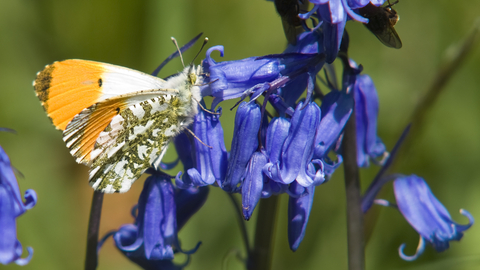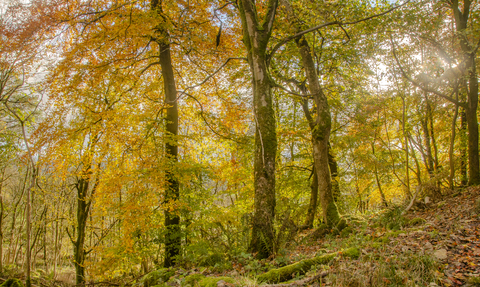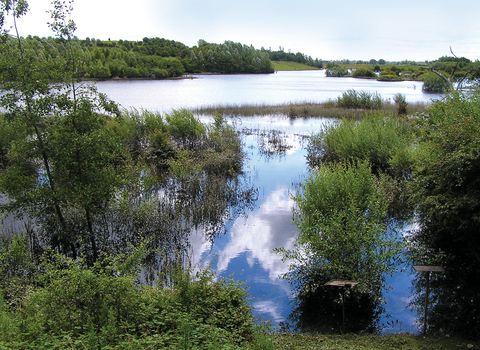Brockadale Nature Reserve - Paul Simmons

Orange-tip ©Bob Coyle

Brockadale Nature Reserve
Location
Know before you go
Dogs
- please see more information regarding dogs below.
When to visit
Opening times
The nature reserve is open at all times, but it can get very busy. If the car park is full or the reserve very busy, please consider coming back another time. We recommend a full day trip to this reserve.Best time to visit
March to SeptemberAbout the reserve
With more than 320 species of plant, 450 species of moth, 30 species of butterfly and 40 species of breeding bird recorded here, one visit to this much-loved reserve is never enough. There’s a wealth of wild experiences for everyone from nature novices to wildlife experts, and a range of terrain from steep magnesian limestone crags to a gentle woodland wander or invigorating riverside ramble.
Brockadale’s steep slopes have never been ploughed or fertilised, resulting in a rare grass- and woodland habitat that’s a wildflower lover’s dream in summer: pyramidal orchids, clustered bellflower and subtly beautiful hellibores are just a few of the many species here to delight you, with rarities including daphne, purple milk vetch and spring cinquefoil. The strikingly patterned marbled white, dark green fritillary and silver-washed fritillary are just three of the butterfly species attracted to the abundant wildflowers.
Not all wildlife is quite so bright and showy, but with time and patience you might be lucky enough to see common lizards and grass snakes on the woodpiles, purse web spiders and clearwing moths. For an even trickier challenge, search for a truncatellina cylindrical – an extremely rare and tiny snail found nowhere else in Yorkshire.
There are bright colours all year round at Brockadale. In spring the woods are filled with bluebells, the vibrant colours of autumn are boosted by the vivid red of scarlet elf cups, and flocks of yellowhammers are regular winter visitors. Look for the blue flash of kingfishers along the river and the hot pink of bullfinches in the hedgerows.
Resident woodland birds like green and great spotted woodpecker, tawny owl, nuthatch and long-tailed tit are joined by breeding chiffchaff, willow warbler, blackcap and whitethroat in spring.
Partnering with Plantlife
As part of our stewardship of Brockadale nature reserve, we have a long-term lease agreement with Plantlife for the management of Thompson Meadow - a 2.88 hectare magnesium limestone meadow in the southeast corner of Brockadale.
Thompson Meadow is a rare example of a pristine wildflower meadow (many of which are sadly disappearing in the UK), and hosts an abundance of rare limestone plants.
We would like to give a special thanks to Andrew Kersey (Reserves Officer at Plantlife) as well Elizabeth Cook (Botanical specialist – Plantlife) and her family for their continued support in managing Thompson Meadow and the wider area.
Species
Contact us
Environmental designation
Seasonal highlights
- Spring: Plants - Wood anemone; Spring cinquefoil; Cowslip; Invertebrates - Orange-tip; Brimstone
- Summer: Plants - Clustered bellflower; Rock-rose; Field scabious: Invertebrates - Dark green fritillary; Marbled white; Bee orchid
- Autumn: Fungi - Woodland fungi Birds - Fieldfare; Redwing
- Winter: Plants - Stinking hellebore; Birds - Nuthatch; Yellowhammer; Corn bunting
Visiting and looking after Brockadale
We're working to protect and manage this special place so it's a thriving home for wildlife. To minimise disturbance to wildlife, camping, cycling and rock climbing are not permitted.
Brockadale is seeing huge numbers of people visiting at the moment. Please help us look after wildlife including ground nesting birds this spring by keeping dogs on leads and stick to paths. Leave only footprints and park responsibly - the small car park can get very busy.
We are unable to fully close the reserve for a number of reasons. Because of this, we might ask people not to visit where we see real damage occurring to the reserve. This gives us a chance to assess the situation and repair any damage.
Walking your dog at Brockadale
We ask that you keep your dog on a lead at all times during your visit and pick up and dispose of your dog poo responsibly by either putting it in the bins provided, or if full, taking it home with you. This is because even a well-behaved dog can cause detrimental damage to the reserve:
- As dogs run and sniff around the reserve, they disturb animals and birds that are in the undergrowth. As an example, when an adult bird is disturbed and flies away, they may not ever return to their chicks. We want to ensure that Brockadale is a thriving home for a variety of wildlife, and minimising disturbance is an important first step.
- We have livestock grazing our land. Not only can dogs disturb or even threaten livestock, there are several nasty diseases which can be transmitted to cattle via dog poo which can be life threatening. At the same time, dogs could be infected by similar nasty illnesses.
- Dog poo does break down in the undergrowth, but it can also change the quality of the soil and can threaten the growth of specialist plants which our native wildlife depends on for food and shelter. In addition, simply putting it in a plastic bag and leaving it around the site doesn't look very nice and adds to plastic pollution which is now recognised as a significant threat to all wildlife. It is also a health risk to our staff working on these sites and to other visitors, especially those with younger families whose children may explore in the undergrowth along the pathways. There is a risk of ocular toxocariasis, which is a disease transmitted from roundworms to humans via fresh and old dog and cat poo. Although rare, it most often affects young children and can have severe effects including blindness.
We want to keep Brockadale looking beautiful! Thank you to all those dog walkers who are conscientious and considerate when bringing their dogs onto the reserve, helping to protect our wildlife from disturbance and disease.
Directions
Public transport
There is an infrequent bus service from Pontefract to Doncaster which stops at either Wentbridge, Kirk Smeaton or Little Smeaton.
By car
From A1 take Wentbridge and Kirk Smeaton turn. Drive east to Kirk Smeaton, go through the village to Little Smeaton and head north west up New Road. Once out of the village turn left down Leys Lane to the car park at the end.
Did you know?
Magnesian limestone only exists in a narrow band between Nottingham and Durham.

The autumn colours were even more beautiful when the sun came out
Photo Credit - Telling our Story Volunteer, Sara



